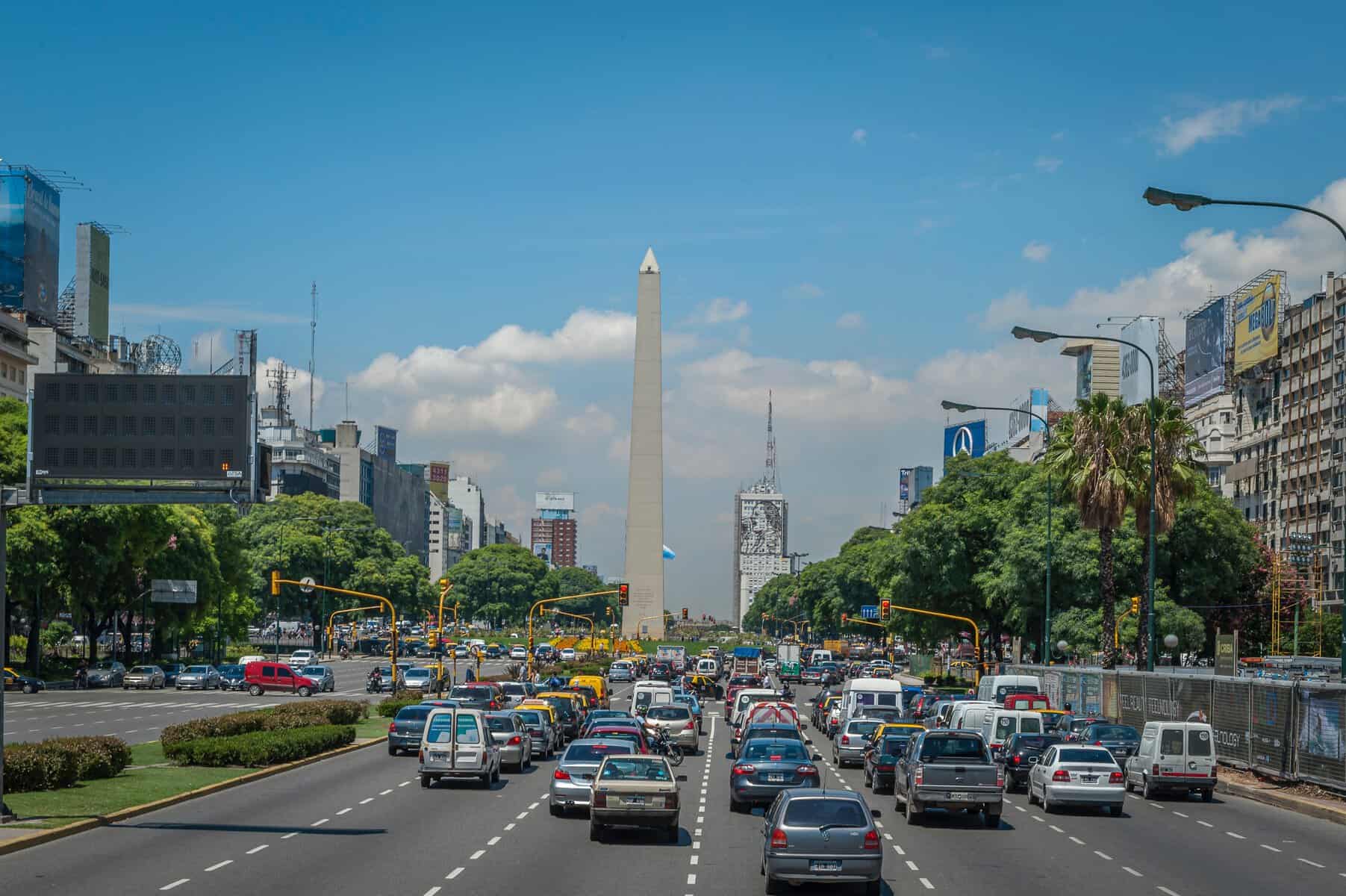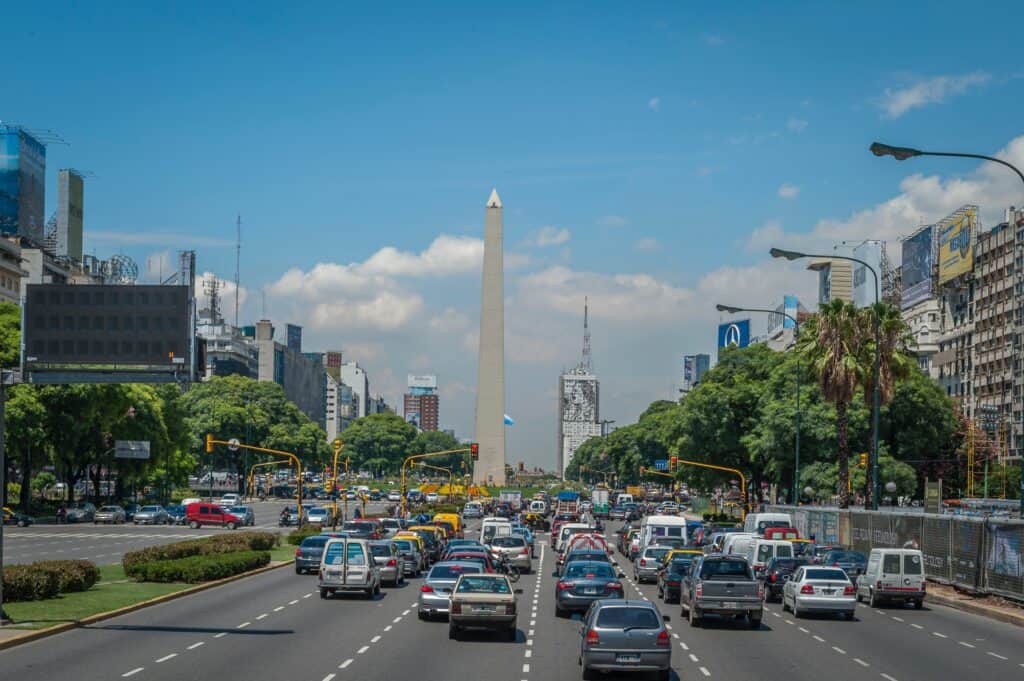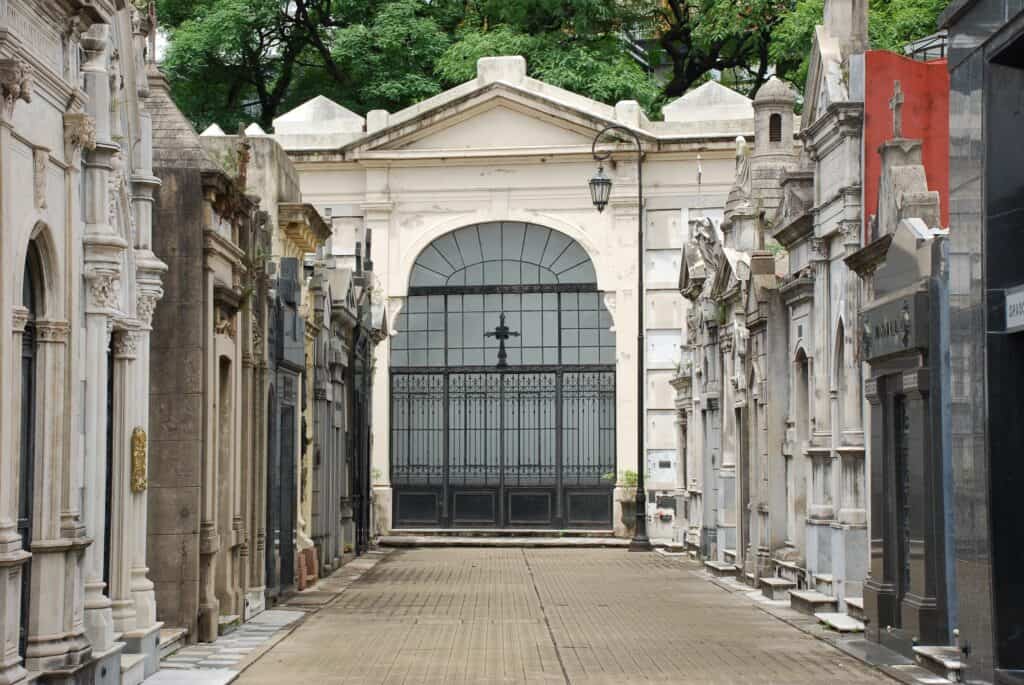
Best Things To Do In Buenos Aires

Welcome to the vibrant and cosmopolitan city of Buenos Aires, where the streets come alive with colour, history, and passion. This city has a unique blend of rich cultural heritage, lively nightlife, and mouth-watering cuisine that leaves visitors to this city in awe.
From the colourful houses in the La Boca neighbourhood, to the ornate mausoleums of Recoleta Cemetery, Buenos Aires is a living museum of Argentine history and culture. But Buenos Aires is not just about history – it’s a city that loves to have fun, too. Dance or watch the tango. Wonder around the neighbourhoods, markets, museums, and parks. Eat great food, drink delicious wine and coffee in a historic cafe or go to an electrifying football match; there is so many things to do.
In this blog post, we will share the best things to do in Buenos Aires. Whether you’re interested in history, culture, sport, food, or nightlife, we’ve got you covered.

Head to the Plaza de Mayo
The Plaza de Mayo is the heart of Buenos Aires, a bustling, iconic square that captures the essence of Argentina’s rich history. Situated in the city centre, the Plaza de Mayo is framed by some of the city’s most important landmarks, including the Casa Rosada, the Metropolitan Cathedral, and the Cabildo.
The square itself has been a focal point for political life and at the centre of the square is the Pirámide de Mayo, a white obelisk erected in 1811 to celebrate the first anniversary of May Revolution, the event that sparked the country’s fight for independence against Spain.

At the eastern end of the Plaza de Mayo stands the Casa Rosada, the presidential palace, with its distinctive pink façade, which has served as a political hub in Argentina.
This palace has witnessed many significant moments in Argentine history, including Eva Perón’s address to the nation from its balcony. Tours to visit Casa Rosada are free, but you must register in advance, either online or at the venue.

Also, overlooking the square is the Metropolitan Cathedral, a neoclassical styled building that from the outside looks more like a greek temple than a catholic church. The buildings origins dates back to the 16th century and has been rebuilt and redesigned several times over the centuries. The interior of the building is impressive with carvings and sculptures. However, one of the main attractions to this site is where you will find the ornate mausoleum of General Jose de San Martin, Argentina’s most revered hero, who led the country and many other South American countries to independence.
Two guards stand at his tomb and there is a changing of the guard ceremony every two hours.
The cathedral is free to visit and open daily until 6:45pm.

Another public and political building also on the square is the Cabildo which was once the seat of the town council. The exterior facade combines baroque, neoclassical, and Moorish architectural styles, with its most distinctive feature being the central bell tower.
This building is now a museum and you can explore the historic stone halls and rooms which are filled with artefacts and interactive displays from the colonial era and May Revolution.
Entrance into the building is free and is open Wednesday to Sunday 10:30am-6pm.
The final building worth noting on the square is the Banco de la Nacion – the headquarters of the country’s national bank.

Walk Along the World’s Widest Street
The world’s widest street Avenida 9 de Julio is named in honour of the country’s independence day and is one of the main arteries of the city. Modelled on Paris’s Champs Elysee but built wider as part of a one upmanship to the older European city.
This busy thoroughfare lined with elegant buildings has at its intersection with Corrientes Avenue the national historic monument and icon of the city, the Obelisco de Buenos Aires.
This towering monument constructed in 1936, stands at a height 71 metres and was built to commemorate the 400th anniversary of the founding of the city.
The Obelisk has served as a backdrop for many celebrations, events, and political protests in the city, making it a dynamic and vibrant gathering place for locals. As one of the most recognizable landmarks in Buenos Aires, a visit to the Obelisk is practically a rite of passage for anyone visiting this city.

Experience World Class Opera
The Teatro Colon, situated on Avenida 9 de Julio is one of the best opera houses in the world. This ornate opera house has seen many famous performances over the years and is considered one of Argentina’s cultural gems.
Stepping inside is like being transported back to another era; its luxurious interior features detailed marble columns, spectacular frescoes, and intricate plasterwork. The auditorium itself is a vision to behold, with gilded balconies and exquisite chandeliers and the acoustics from the stage are said to be perfect.
Whether taking a theatre tour or seeing a performance, the place will take your breath away.
Theatre tours and tickets for performances can be purchased through the theatres website.

Take A Break in a Historic Cafe (Bars Notables)
Buenos Aires is renowned for being home to some of the most prestigious historic cafes in South America. Known as Bar Notables, these establishments have been declared as National Historical Monuments of Argentina due to their rich history and cultural value. These bars originally served as meeting points for intellectuals, writers, artists, and politicians, becoming essential places for Buenos Aires’ cultural development.
A visit to one of these historical bars is an opportunity to step back in time and experience the unique atmosphere of Buenos Aires’ rich cultural heritage.
Here are some of the best bar notables to visit:
- Cafe Tortoni: Located in the heart of the city, Cafe Tortoni is one of the oldest of the most famous cafes in Buenos Aires. Established in 1958, this bart has been a hub for intellectuals, artists, and politicians for over a century. Located on Avenida de Mayo 815 and is open daily from 8am-9pm.
- Cafe La Biela: Founded in 1850, Cafe La Biela is a traditional cafe that has retained its old-world charm. The cafe was renamed after the connecting rod in a car engine because it became a popular meeting place of racing drivers. Located on Avenida Quitana 600 and open daily from 7am-2am.
- Bar Británico: This bar opened in 1928 and was a gathering place for veterans from the First World War and also rail workers. Located on Avenida Brazil 399 and open daily from 7am-3am.
- Bar El Federal: Bar El Federal has been around since 1864, making it one of the most well-established bars in the city. Located in the historic San Telmo neighbourhood, the inside is rustic and decorated with antique adverts and plaques. Located on Carlos Calvo 599 and open daily from 8am-2am.
- Cafe La Poesia: This beloved cafe located in the historic San Telmo neighbourhood was a meeting place for poets in the 1960s. Located on Chile 502 and open daily 8am-2am.

Visit Book Shop Heaven
This city has over 700 bookshops and is considered the bookshop capital of the world and El Ateneo Grand Splendid has to be the crown jewel.
Considered one of the world’s most beautiful bookshops, this once former theatre is now a bibliophile’s heaven. Upon entering the store, visitors are greeted by the sight of the elaborate frescoes, sculptures, and ornate balconies that make up the interior’s decor.
Located in the neighborhood of Recoleta, El Ateneo Grand Splendid is a must-visit for all book lovers visiting Buenos Aires. Whether you’re seeking some reading material in a charming setting or simply want to admire the architecture, El Ateneo Grand Splendid is a must.

Explore the Historic Neighbourhood of San Telmo
San Telmo is a charming and bohemian neighbourhood of Buenos Aires, filled with cobblestone streets, colourful houses, and a lively atmosphere. It is the oldest neighbourhood in the city and dates back to the 17th century. Packed with antique shops, traditional tango bars, and street artists, San Telmo is the perfect place to visit for an authentic Argentinian experience.
The heart of San Telmo is the famous Plaza Dorrego, a square where visitors can enjoy tango dancers perform and drink coffee at the various cafes surrounding the square.

Located about five minutes from the plaza is San Telmo market. An indoor market that originally housed fruit and vegetable stalls has over the years expanded to include antique shops and delicious food stalls.

Some of the local favourites to eat here are:
- Choripan: A grilled chorizo sausage sandwich, often topped with chimichurri sauce.
- Empanadas: Savory pastries filled with meat, cheese, or vegetables.
- Asado: A classic Argentinean barbeque, with beautifully grilled meats.
- Milanesa: Breaded meat or chicken cutlets, often served with mashed potatoes and tomato sauce.
Some of the standout food stalls and restaurants in the San Telmo Market include:
- El Banco Rojo: A casual eatery serving up delicious asado and parrillada.
- La Cocina: A popular spot for empanadas, pizza, and other tasty snacks.
- Coffee Town: The perfect place to stop for coffee.
Every Sunday (10am-5pm) the area hosts a street market that stretches from Defensa Street to Plaza Dorrego and is packed with stalls selling antiques, artisanal crafts, clothing, jewellery and food.

Visit Working Class La Boca
The most popular photo cover on travel guides to Buenos Aires is taken from the streets of La Boca. This colourful neighbourhood is where immigrants settled when they first arrived from Europe. This still gritty working class neighbourhood is now home to the city’s art scene and is also home to the famous football club – Boca Juniors.
But La Boca is more than just colorful houses; it is an emblem of Buenos Aires’ cultural history and spirit. The Museo Quinquela Martín celebrates the life and work of the famous Argentinean painter who was born and raised in La Boca. The Fundación Proa exhibits contemporary art from all over the world, while the Usina del Arte is a cultural center that showcases music, dance, and theater performances.
The heart of La Boca is the bustling Caminito street, filled with outdoor cafes, restaurants, and artisan shops that offer a taste of traditional Argentinean culture and cuisine. Visitors can enjoy delicious empanadas and steak dinners while watching the live music performances and street tango shows that make this neighborhood so vibrant and lively.

For football fans, a visit to home stadium of Boca Juniors is a thrilling experience. Boca Juniors is one of the most popular and successful football clubs in Argentina and has a long and rich history in the city. The Iberian Jose Armando Stadium widely known as La Bombonera (the chocolate box) is an incredible place to experience a football match, with passionate fans who sing and chant throughout the entire game. The atmosphere is electric, and the energy of the crowd is infectious. Even when there are no games scheduled, visitors can take a tour of the stadium, exploring the locker rooms, walking on the field, and seeing the trophy room. A visit to La Bombonera remains a must-do for anyone who loves football.

Explore The Fancy Neighbourhood Of Recoleta
During the 19th century, the neighbourhood of Recoleta transformed into one of the city’s wealthiest areas, attracting many of the city’s elite resident. Today Recoleta continues to be an affluent and popular neighbourhood known for its grand architecture and upscale boutiques and hotels.
The star attraction of Recoleta is the famous Recoleta Cemetery and is considered one of the most beautiful cemeteries in the world. The final resting place of Argentina’s most famous and wealthy citizens, including Eva Perón, the country’s beloved former first lady.
The architecture of the tombs and mausoleums is nothing short of incredible, with grand sculptures, ornate columns, and intricate details on each structure.
The cemetery is free to visit and open daily from 8am to 6pm.
Another key attraction in the Recoleta neighbourhood is the National Museum of Fine Arts (MNBA) which displays an extensive international and Argentinian art collection; including works by Rembrandt, Van Gogh, Picasso, and Goya.
Admission for the permanent exhibition is free and the museum is open Tuesday to Sundays from 11am-8pm.
Other attractions in Recoleta include the Cultural Centre and the beautiful Floralis Generica sculpture (which is next to the fine arts museum).

Indulge in Pizza & Ice Cream
Over 15 million people in Argentina are from Italian decent and therefore it is no wonder that this city is full of great pizzerias.
However, pizza here has taken its own identity and is served deep pan and covered with loads of cheese and served eaten with a slice of faina, a chickpea style bread, to soak up all that cheese.
Two of the best places to eat traditional Argentinian Pizza are El Cuartito which opened in 1934 and Pizzeria Guerrin that opened in 1932.
The ice cream is also very special here and there are heladerias (ice cream parlours) throughout the city. The gelato is soft and creamy and will be some of the best you will have eaten.
One of the most famous heladerias is Freddo, with locations throughout the city. Their dulce de leche flavor is a must-try. Other recommended ice cream shops include Rapa Nui, which features a variety of unique flavour combinations.
Enjoy the Country’s Best Exports – Steak & Wine
For carnivores there is no better place in the world to eat steak than in Argentina and some of the best steak houses are in Buenos Aires. Enjoy one of the many cuts with a glass of the local Malbec, the countries beloved and famous grape, it will be a very memorable meal.

Embracing the Seductive Rhythm of Tango
Tango is not just a dance, but a way of life in Buenos Aires. Born in the shantytowns of the city in the late 19th century, tango has since become a symbol of Argentine culture, sensuality, and passion. Walking through the streets of Buenos Aires, you can hear the sounds of the bandoneon, a type of accordion commonly used in tango music, drifting from the windows of cafes and milongas, the tango dance halls.
The spirit of tango can be felt throughout the city, but nowhere is it more prominent than in the neighborhood of San Telmo, where the cobbled streets and historic architecture create a timeless and romantic atmosphere. Visitors can watch tango dancers perform on the street or take classes themselves.
One of the most popular tango events in the city is La Catedral, a milonga where both locals and tourists dance the tango.
For those interested in learning more about the history of tango, the Carlos Gardel Museum pays homage to one of the genre’s most famous musicians. Gardel’s sultry voice and smooth moves helped popularize tango around the world, and his legacy is celebrated throughout Buenos Aires.
Experiencing tango in Buenos Aires is a must-do for anyone visiting the city. The dance form has a blend of sensuality, melancholy, and rhythm that creates an unforgettable ambiance that is unique to Buenos Aires. So put on your dancing shoes and step into the seductive world of tango.

So to wrap on the Best Things To Do In Buenos Aires…
Buenos Aires is an incredible city, and nobody should miss out on exploring all that it has to offer. From its stunning architecture and rich history, to its delicious food and lively nightlife, there’s something for everyone in the City of Tango. Whether you’re a first-time visitor or a regular to the city, take time to plan your greatest adventure yet in Buenos Aires! With everything that lies ahead of you, it’s sure to be a remarkable experience. So, why wait? Get planning your amazing trip today – it’ll be one that you won’t forget anytime soon!
Read this great blog post blog on The Best Day Trips From Buenos Aires.
Further FAQs
When is the Best Time to Visit Buenos Aires?
The ideal times to visit Buenos Aires are during March to May or September to November, which are the fall and spring seasons respectively.
Which Airports Serve Buenos Aires?
Buenos Aires is served by two major airports
Ministro Pistarini International Airport, located in Ezeiza, about 30km from the centre, and Aeroparque Jorge Newbery, located in the Palermo neighbourhood of Buenos Aires.
Ministro Pistarini International Airport, also known as Ezeiza International Airport, is the largest international airport in Argentina, serving flights from all over the world. Aeroparque Jorge Newbery is a domestic airport that also serves flights to other countries in South America.
Taipei and the north experience some 95 inches of rainfall yearly, reaching a peak in the summer months between June to September.
What Local Transport Options Are Available?
The city offers a range of transport options to help you explore the city quickly and easily.
Buses: Buses are a popular mode of transport in Buenos Aires, with a vast network that covers most of the city. The buses are divided into different categories, including ordinary, semi-rapid, and rapid buses.
Subway: Known as the “Subte, the subway is a a fast and efficient way to get around the city. The system has six lines and 90 stations, covering many parts of the city. The Subte is fast, affordable, and reliable, making it one of the best transport options for getting around Buenos Aires.
Taxis: Taxis are readily available in Buenos Aires and are a convenient way to get around the city, especially at night. Taxis can be hailed on the street and the fares are very affordable considering other cities of higher tourism rates.
Where to Stay?
Buenos Aires has a diverse range of neighborhoods, each with its unique vibe, attractions, and features, making it important to choose the right one for your stay. Here’s a comprehensive guide to the best neighborhoods to stay in Buenos Aires that cater to different interests and budgets:
Palermo: Palermo is one of the most popular neighborhoods to stay in Buenos Aires for tourists, with its stylish ambiance, colorful street art, and vibrant nightlife. It is also home to some excellent restaurants, breweries and hosts a variety of shopping opportunities.
San Telmo: San Telmo neighborhood is famous for its historic streets, antique shops, and tango bars, making it an excellent choice for those seeking a traditional Buenos Aires experience.
Recoleta: Recoleta is a sophisticated neighbourhood known for upscale shopping, chic cafes, and high-end restaurants. It is an excellent choice for those who prefer an affluent atmosphere.
Microcentro: For those who enjoy being near the heart of the city, Microcentro is an excellent neighbourhood to choose for your stay. As it is the most central, this neighbourhood offers easy access to some of the city’s most popular tourist attractions.
For some great Hotel Hacks, read our Best Hotel Hacks blog post.
https://inspiredtravelhacks.com/best-hotel-hacks-that-every-traveller-should-know/
Is Buenos Aires Safe?
Buenos Aires is generally a safe city, but like any major city, it’s important to take precautions to stay safe. Common sense actions like avoiding poorly lit or unfamiliar areas at night, keeping any valuables out of sight, and not carrying excessive amounts of cash.
It’s also important to be aware of your surroundings, especially in busy tourist areas where pickpocketing and other petty crimes can occur. Overall, if you take reasonable precautions, Buenos Aires is a safe and welcoming city to visit.
Read our 35 Most Important Travel Safety Tips You Should Know for great advise on all things travel safety.

